Understanding the Steps of How to Become a Freemason with Simplicity
Understanding the Steps of How to Become a Freemason with Simplicity
Blog Article
Exploring the Mysteries of the Freemason: What You Need to Know
The Freemason, a term frequently shrouded in intrigue and dispute, stands for an intricate tapestry of historic reality and modern-day misconception. Established in the late 18th century, this secret society was initially rooted in the Enlightenment's ideals but has because become associated with conspiracy theories about elite control. As we navigate the origins, key figures, and the raw comparison in between misconception and reality, one should think about exactly how these narratives influence modern perceptions of power and secrecy. What may be disclosed through a more detailed examination of these aspects might test long-held presumptions concerning the darkness that stick around in our culture.
Beginnings of the Freemason
The origins of the Freemason are soaked in a blend of historical intrigue and ideological fervor. Developed in 1776 in Ingolstadt, Bavaria, by Adam Weishaupt, the group was originally developed as a secret culture targeted at promoting Enlightenment perfects such as reason, secularism, and the splitting up of church and state. Weishaupt, a professor of canon legislation, looked for to challenge the dominating authority of the church and state, which he deemed overbearing institutions stifling intellectual and individual freedom.
The Freemason looked for to hire prominent participants from different social industries, consisting of politics, academic community, and the arts, to foster a network devoted to these Knowledge principles. The society run under a shroud of privacy, employing coded language and rituals to shield its members from oppression, specifically provided the repressive environment of the moment. The Freemason dealt with significant opposition from both governmental authorities and spiritual institutions, which checked out the team as a risk to their power.
Trick Figures and Participants
That were the critical numbers that shaped the Freemason's very early impact and instructions? The Bavarian Freemason, founded in 1776 by Adam Weishaupt, arised as an action to the oppressive social structures of the time. how to become a freemason. Weishaupt, a law teacher, imagined the company as a way to promote Knowledge perfects such as factor, secularism, and equality. His first recruitment initiatives included influential intellectuals, such as Baron von Knigge, that played a vital duty in increasing the team's membership and business structure.
One more considerable figure was Johann Gottlieb Fichte, a prominent thinker whose concepts on nationalism and education resonated with the Freemason's objectives. Although Fichte was not an official participant, his philosophical foundations influenced the team's ideological background. In addition, numbers like the writer and thinker Johann Wolfgang von Goethe were connected with the broader intellectual activities of the time, although their direct participation with the Freemason stays discussed.
These key numbers added to the Freemason's very early instructions, pushing the boundaries of political and social idea, while their cumulative efforts aimed to test recognized standards and promote a climate of dynamic modification in Europe.
Myths vs. Fact
Lots of misconceptions surround the Freemason, commonly blending reality with fiction in a means that obscures its true nature. The notion that the Freemason continues to apply substantial impact over globe occasions is a myth - how to become a freemason.
An additional widespread myth is that the Freemason makes up a network of elite people adjusting global affairs. Actually, lots of conspiracy theory concepts exaggerate the group's relevance, connecting misguided objectives to societal trends and events. This has caused an oversimplified sight of intricate concerns.

Modern Analyses
Contemporary analyses of the Freemason frequently show more comprehensive social anxieties and a fascination with secrecy and power. This contemporary lens regularly links the Freemason with conspiracy theory theories that suggest a covert elite manages world occasions, controling federal governments and economies for their own gain. Such narratives use a deep-seated mistrust of authority, specifically in times of crisis or social upheaval.

Additionally, some modern-day analyses mount the Freemason as a metaphor for the complexities of globalization and the interconnectedness of influential individuals and organizations. This viewpoint urges a crucial examination of how power characteristics run in today's globe, highlighting the balance between openness and privacy in governance and corporate practices.
Social Influence and Tradition
Influenced by centuries of intrigue, the cultural impact and legacy of the Freemason expand much beyond its historic beginnings. This secret culture, established in the late 18th century, has penetrated different facets of pop culture, from literature and movie to songs and art. The idea of the Freemason has actually progressed into a symbol of conspiracy theory theories, frequently standing published here for a regarded covert power manipulating international occasions.
In literature, writers like Dan Brown have woven the Freemason right into complex plots, exciting visitors with themes of privacy and power. Films such as "National Prize" and "The Da Vinci Code" even more perpetuate the attraction of the society, mixing truth with fiction to create interesting narratives.
The Freemason's impact likewise extends right into songs, with artists referencing the organization to evoke motifs of disobedience and social critique. This portrayal has contributed to a fascination with the concept of clandestine teams managing the levers of power, reflecting social anxieties about authority and transparency.
Inevitably, the Freemason's tradition is official site an intricate tapestry of myth and fact, shaping perceptions of secrecy and control in modern discourse. Its long-lasting presence in society highlights humanity's seasonal quest for recognizing concealed truths.
Verdict
The exploration of the Freemason reveals a complex interaction between historical facts and modern myth-making. Established in the Enlightenment period, this society aimed to challenge overbearing frameworks, yet its heritage has been overshadowed by conspiracy concepts that recommend elite adjustment. Understanding the distinctions between the original suitables and modern analyses is important for comprehending the withstanding attraction with the Freemason and its substantial impact on social stories bordering power and privacy in culture.
Report this page